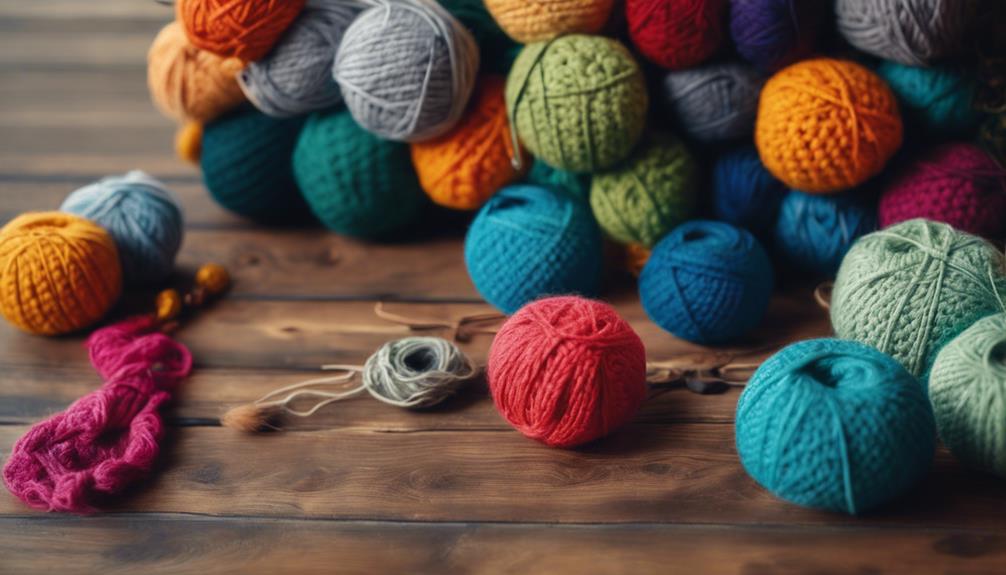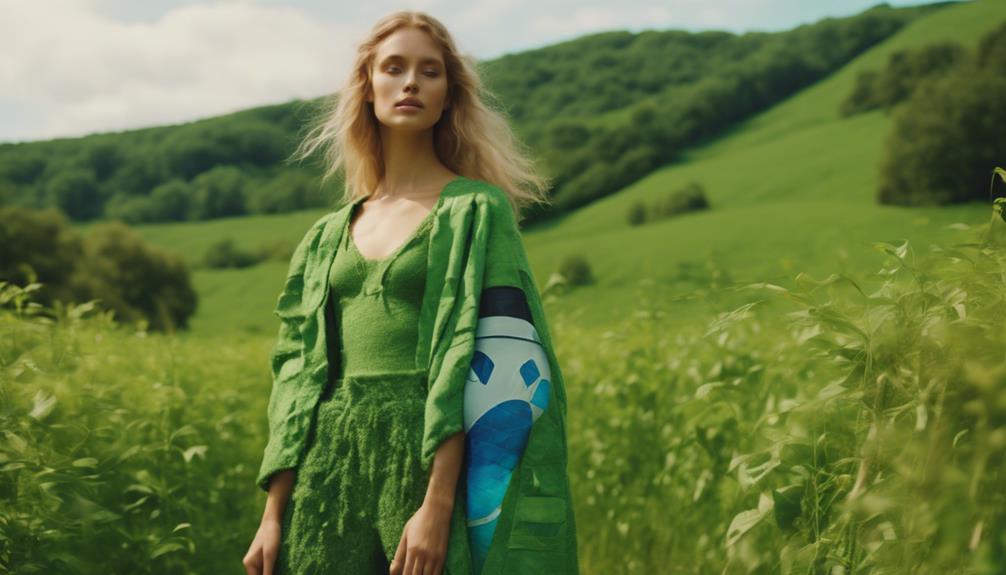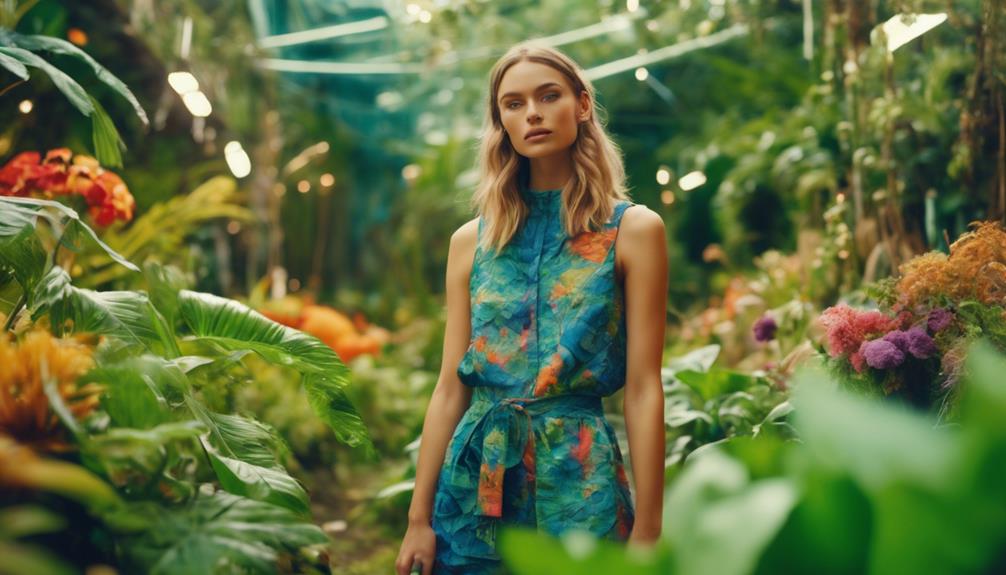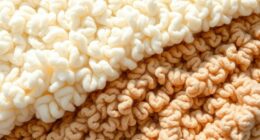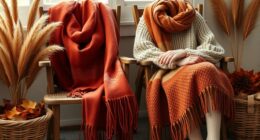Yes, crocheting is truly a sustainable fashion option that may surprise you! By utilizing eco-friendly materials such as organic cotton and recycled fibers, you are actively decreasing dependence on fast fashion. Crocheting promotes ethical craftsmanship, showcasing unique, handmade pieces instead of mass-produced clothing. Additionally, you can practice upcycling by transforming old garments into yarn, reducing waste in the process. Each stitch links you to a vibrant cultural background while supporting local artisans. This mindful approach nurtures personal style and respect for craftsmanship. If you’re interested in embracing sustainable crochet, there is plenty more to discover!
Key Takeaways
- Crochet promotes sustainability by using eco-friendly materials, reducing reliance on fast fashion and minimizing environmental impact.
- Upcycling techniques in crochet transform old textiles into new creations, decreasing waste and fostering creativity.
- Supporting local artisans through crochet reduces carbon emissions associated with shipping and ensures ethical sourcing of materials.
- The craft connects generations, preserving cultural heritage while encouraging mindful consumption and appreciation for craftsmanship.
Defining Sustainable Fashion
Sustainable fashion focuses on creating clothing and accessories that don't harm the planet or exploit people, prioritizing eco-friendly materials and ethical labor practices.
It's about making conscious choices that benefit both the environment and the workers involved in production. When you choose sustainable fashion, you support brands that emphasize transparency and fairness in their manufacturing processes.
This means looking for materials that aren't only renewable but also have a lower environmental impact. Organic cotton, hemp, and recycled fabrics are some examples that embody these principles.
Ethical practices extend to labor conditions too—ensuring workers receive fair wages and work in safe environments.
As consumer demand for responsible fashion rises, the global market for sustainable apparel is projected to hit $27.2 million by 2033. This shift reflects a growing awareness of the fashion industry's effects on our planet.
By embracing sustainable fashion, you make a positive statement, encouraging brands to adopt ethical practices and reducing the reliance on harmful synthetic fibers.
In this way, you become part of a movement that seeks to redefine how we view and consume fashion, paving the way for a more sustainable future.
The Fashion Industry's Environmental Costs
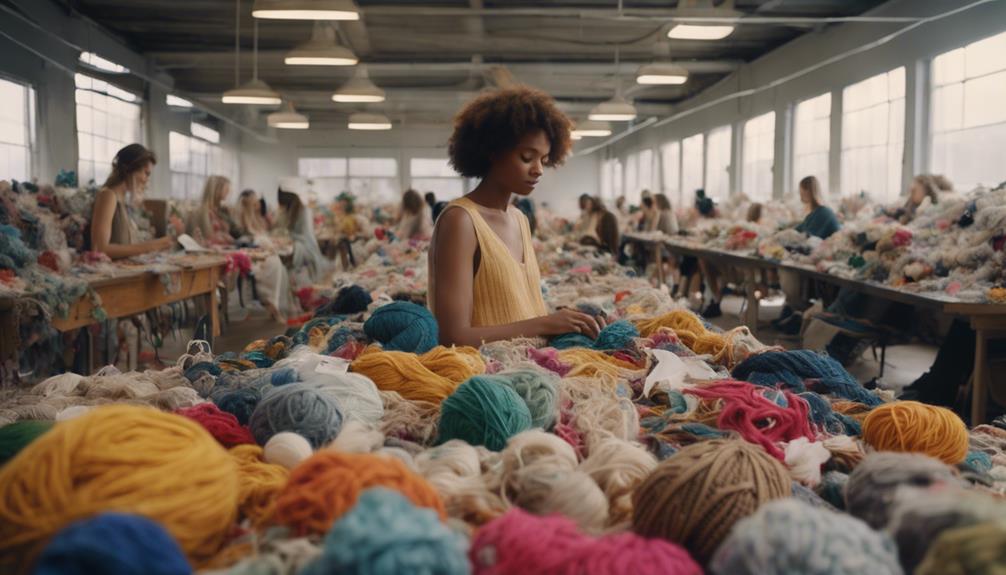
The fashion industry has a staggering environmental cost, contributing around 10% of global carbon emissions and heavily impacting our planet. When you consider fast fashion, the problem escalates. This model encourages rapid production and consumption, leading to around 92 million tons of apparel waste each year. That's a massive amount of clothing ending up in landfills, where it contributes to pollution and resource wastage.
You mightn't realize how much water is consumed in textile production either. For instance, it takes a shocking 3,781 liters to produce just one pair of jeans. This excessive water usage adds to the environmental impact, especially in regions already suffering from water scarcity.
Additionally, two-thirds of clothing is made from synthetic fibers, which are derived from crude oil. This not only disrupts habitats but also increases carbon emissions due to the fossil fuel extraction process. Plus, shipping these garments contributes another 8%-10% of global carbon emissions annually.
All these factors combined illustrate that the fashion industry's environmental costs are significant, raising urgent questions about the sustainability of our clothing choices.
Advantages of Crocheting
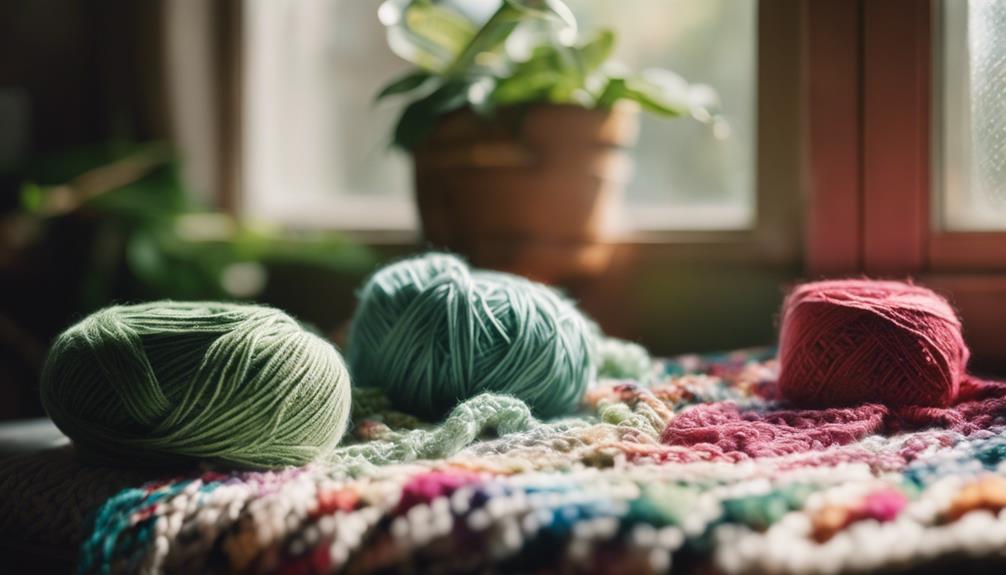
Crocheting offers a multitude of advantages, particularly in promoting eco-friendly fashion choices and reducing waste. When you engage in this craft, you're not just creating beautiful crochet garments; you're also making a sustainable option that benefits the environment.
Here are three notable advantages of crocheting:
- Eco-Friendly Materials: You can choose organic cotton or recycled fibers, reducing your reliance on fast fashion and its environmental impact.
- Unique Creations: Each piece you create is handmade, showcasing your unique style and supporting ethical production practices, contrasting sharply with mass-produced items.
- Upcycling Potential: By transforming old clothing into yarn, you considerably decrease waste, contributing to a more sustainable fashion cycle.
Additionally, crocheting fosters a deeper connection to your wardrobe, encouraging mindful consumption and appreciation for the craftsmanship behind each unique piece.
Plus, the mental health benefits can't be overlooked; crocheting serves as a stress reliever and a creative outlet.
Steps for Sustainable Crocheting
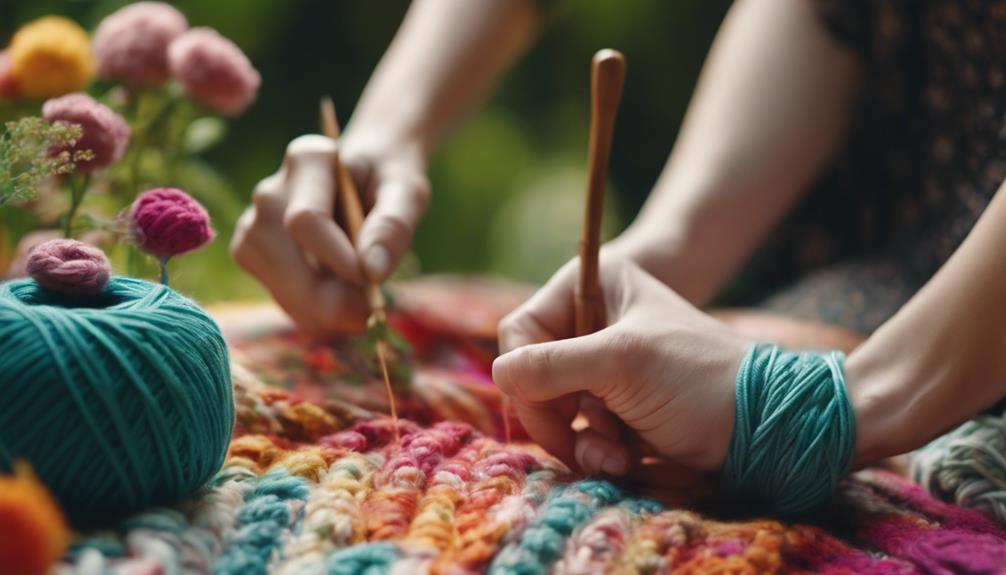
When you crochet, making eco-friendly choices can greatly impact sustainability.
You can start by selecting yarn made from sustainable materials and exploring upcycling techniques to reduce waste.
Supporting local artisans not only strengthens your community but also cuts down on carbon emissions from shipping.
Eco-Friendly Yarn Choices
Choosing eco-friendly yarn is essential for making sustainable crochet projects that are both stylish and environmentally responsible. By selecting the right materials, you not only enhance your creations but also contribute to a healthier planet.
Here are three eco-friendly yarn choices to take into account:
- Organic Cotton: Free from harmful chemicals, this soft yarn is perfect for garments that are gentle on the skin.
- Bamboo Yarn: Lightweight and breathable, bamboo yarn is an excellent choice for warm-weather projects while being sustainably sourced.
- Recycled Fibers: Made from repurposed materials, these fibers reduce waste and offer durability, making them ideal for various crochet items.
When you choose yarn that's both sustainable and ethical, you support local artisans and reduce carbon emissions linked to shipping.
Plus, opt for natural dyes derived from plants or fruits to achieve unique, earthy tones. Researching the origins of your yarn guarantees that your crochet projects align with your values, allowing you to create beautiful pieces with a clear conscience.
Embrace eco-friendly yarn choices, and make a positive impact with every stitch!
Upcycling and Recycling Techniques
Upcycling old clothing into new yarn not only reduces landfill waste but also inspires creativity in your crochet projects. By transforming unworn or damaged shirts into t-shirt yarn, you can craft unique items like bags or rugs. This technique exemplifies how upcycling can breathe new life into textiles.
Recycling synthetic fibers in your crochet work is another way to promote sustainability. Using non-biodegradable materials responsibly helps mitigate environmental impacts. You can also utilize remnants from previous projects; turning leftover yarn into smaller items like coasters or keychains is a great way to reduce waste while exercising your creativity.
Here's a quick overview of some effective upcycling and recycling techniques:
| Technique | Description |
|---|---|
| T-shirt Yarn Creation | Transform damaged shirts into crochet yarn |
| Synthetic Fiber Projects | Use recycled synthetic materials |
| Remnant Projects | Create small items from leftover yarn |
| Yarn Swaps | Exchange materials with others in the community |
| Upcycled Accessories | Craft unique accessories from old textiles |
Supporting Local Artisans
Supporting local artisans not only enhances your crochet projects but also contributes to a more sustainable fashion ecosystem. When you choose to support local yarn, you're making a conscious decision that impacts your community and the environment. Here's why it matters:
- Reduce Carbon Footprint: By buying locally, you cut down on shipping emissions, making your crochet practice more eco-friendly.
- Ethical Sourcing: Local artisans often prioritize ethical practices, guaranteeing that materials are sourced responsibly and sustainably compared to mass-produced yarns.
- Unique Craftsmanship: Each piece of yarn from local artisans carries a story, adding emotional depth to your creations that factory-made products simply can't match.
Engaging with local artisans not only helps preserve traditional crafting techniques but also strengthens your connection to the community. You'll have a clearer understanding of where your materials come from, allowing you to guarantee ethical labor practices are upheld.
Cultural Insights on Crochet
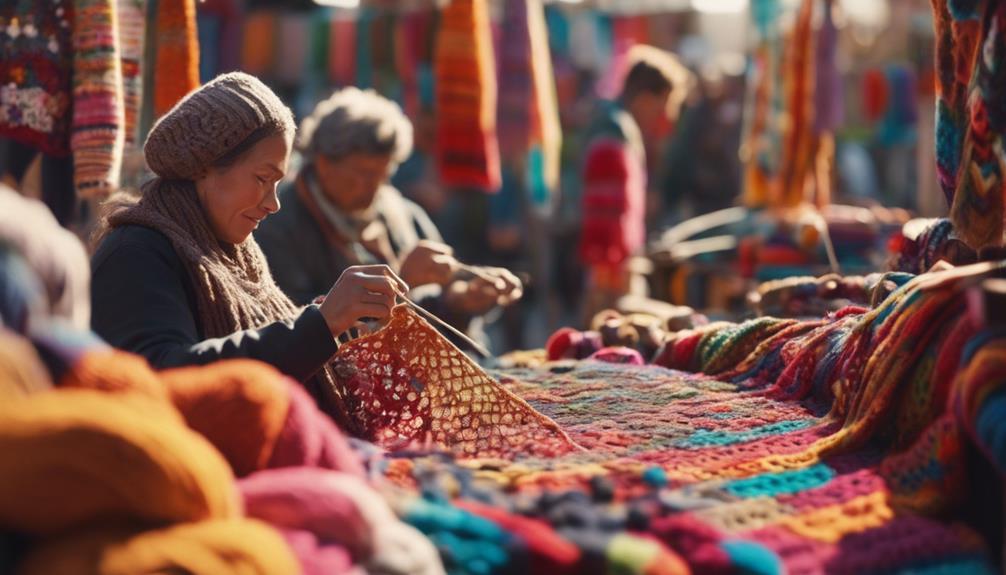
When you explore the cultural insights on crochet, you'll discover its rich historical significance and how it connects communities globally.
You might find that crocheting isn't just a craft; it's a way to express personal and cultural stories.
As you engage with this art form, you'll see how it reflects unique traditions and fosters connections among makers and wearers alike.
Historical Significance of Crochet
Crochet holds deep historical roots, with evidence tracing similar needlework back to the 16th century in Europe, highlighting its enduring cultural significance. Over time, crochet has evolved from a domestic craft to a symbol of artistic expression and sustainable fashion. It's fascinating how this art form intertwines with cultural narratives, reflecting societal values and personal stories.
Consider the impact of crochet throughout history:
- Empowerment: Women used crochet projects to assert their creativity and independence, often creating beautiful pieces that conveyed their skills and heritage.
- Connection: Crochet has served as a communal activity, where people gather to share techniques, fostering a sense of belonging and preserving cultural knowledge.
- Sustainability: By embracing traditional methods, contemporary designers are crafting sustainable pieces that honor the past while addressing modern fashion needs.
The cultural significance of crochet is profound, as it embodies resilience and adaptability. Each stitch not only creates a functional item but also bridges generations, making crochet a timeless craft with a rich history that continues to inspire and connect people today.
Global Crochet Communities Today
Global crochet communities today thrive through vibrant online platforms, uniting enthusiasts who share their unique styles and sustainable practices. You can find countless crochet patterns and tutorials on sites like Instagram and TikTok, where creators showcase their work and inspire others to embrace sustainability. These platforms not only highlight diverse techniques but also promote the use of eco-friendly materials, encouraging members to rethink their fashion choices.
Many local crochet groups emphasize craftsmanship, supporting artisans and fostering a sense of community. By prioritizing handmade garments over mass-produced items, these communities contribute to reducing waste and advocating for sustainable practices in the fashion industry.
Cultural traditions also play a significant role in these global crochet communities. Techniques like Japanese Amigurumi and Irish lace crochet reflect unique artistic expressions, enriching the craft's diversity.
As you engage with these online and local communities, you'll discover a shared passion for creativity and self-expression while aligning with slow fashion principles. In this way, crocheting not only becomes a personal journey but also a collective effort towards a more sustainable and connected world.
Cultural Expressions Through Craft
Embracing crochet opens up a world of cultural expressions, where each stitch tells a story rooted in tradition and identity. As you immerse yourself in this craft, you'll discover how crochet embodies unique histories and connects communities.
Consider these three emotional aspects of crochet as sustainable fashion:
- Heritage and Identity: Each pattern reflects the unique culture it originates from, celebrating the diversity of crochet techniques worldwide.
- Storytelling: Specific motifs convey cultural symbols and histories, turning each piece into a narrative that honors traditions.
- Community Bonds: Crochet often brings people together, fostering connections through collaborative projects that strengthen cultural ties.
As sustainable fashion gains momentum, crochet takes center stage, allowing artisans to weave traditional techniques into eco-friendly garments. This not only preserves cultural practices but also promotes a conscious approach to fashion.
By choosing crochet, you're not just wearing a piece of clothing; you're embracing a rich tapestry of cultural expressions that honor the past while paving the way for a sustainable future.
The Fast Fashion Dilemma
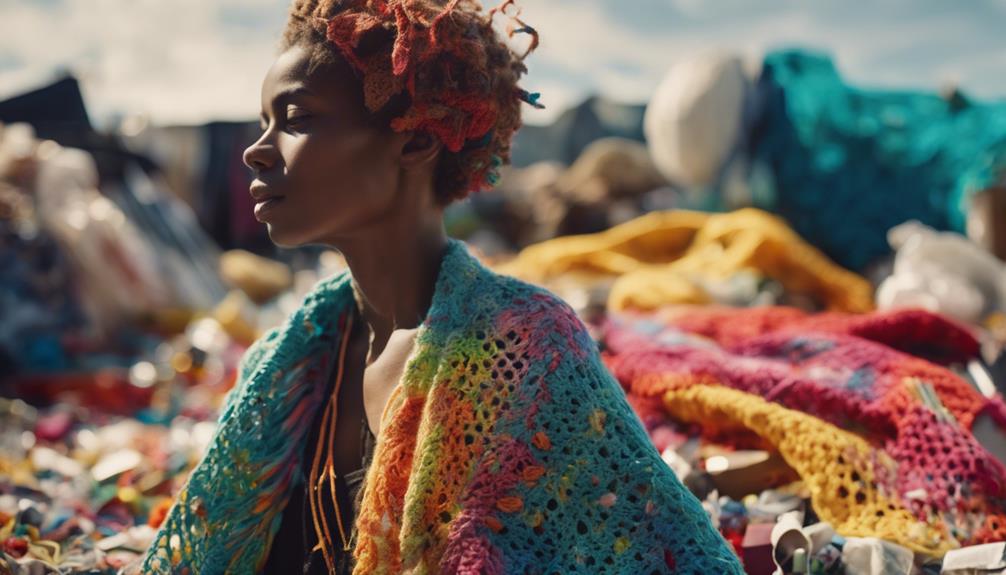
The fast fashion industry poses a considerable threat to our planet, contributing around 10% of global carbon pollution and driving environmental degradation.
You mightn't realize it, but every time you purchase a cheap garment from brands like Shein, you're supporting a system that exploits workers and encourages overconsumption. These workers often earn below a living wage and face harsh working conditions, receiving only one day off per month and being fined for mistakes.
The rapid production cycles in fast fashion lead to staggering waste, with an estimated 92 million tons of apparel ending up in landfills each year. This cycle not only harms the environment but also distances you from the true cost of your clothing.
As consumers, you're becoming increasingly aware of the hidden costs associated with fast fashion, thanks to viral posts that expose the contrast between low retail prices and the ethical implications behind them.
Shifting towards slow fashion offers a solution. By prioritizing quality over quantity, you can foster a deeper connection with your clothing, reduce waste, and considerably lessen your environmental impact.
It's time to rethink your shopping habits and choose sustainability over the fleeting allure of fast fashion.
Crafting Personal Style
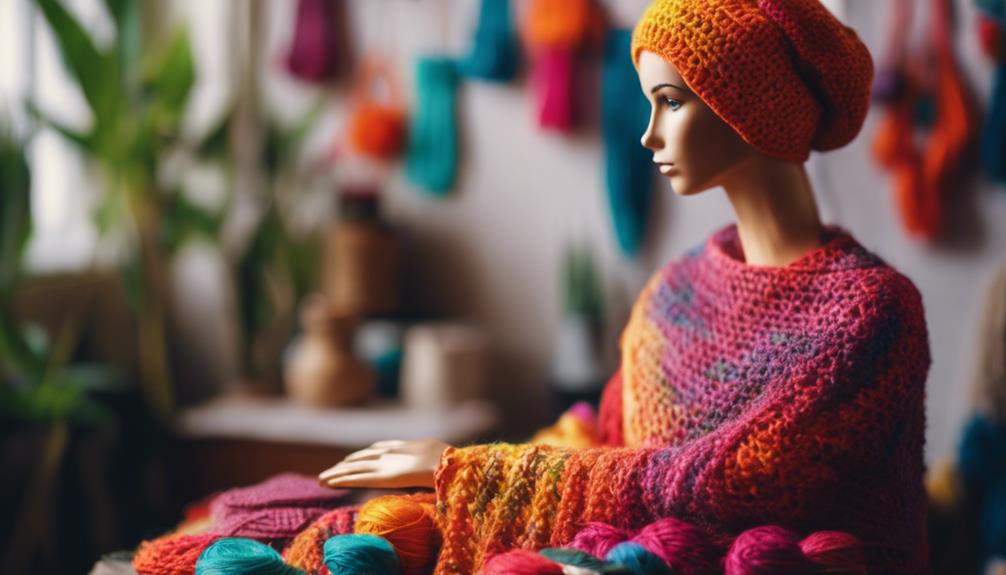
As you move away from fast fashion, crocheting offers a unique way to express your personal style and create one-of-a-kind garments that truly reflect who you are. Unlike mass-produced clothing, crochet allows you to embrace your individuality through the ability to customize every piece.
Here's why it's so special:
- Unique Stories: Each handmade item carries a story, showcasing your journey and creativity, setting you apart from the identical pieces found in stores.
- Perfect Fit: You can tailor your garments to your exact tastes and body shape, ensuring comfort and style that off-the-rack options can't match.
- Sustainable Choices: By selecting eco-friendly yarns and sustainable practices, you contribute to ethical fashion, making a positive impact on the planet.
Crocheting not only helps you curate a versatile wardrobe of quality staples but also fosters a deeper connection with your clothing.
It's about more than just fashion; it's a celebration of you and your values, making each piece a true reflection of your unique identity.
Embrace this craft, and watch your personal style flourish!
The Therapeutic Benefits of Crochet
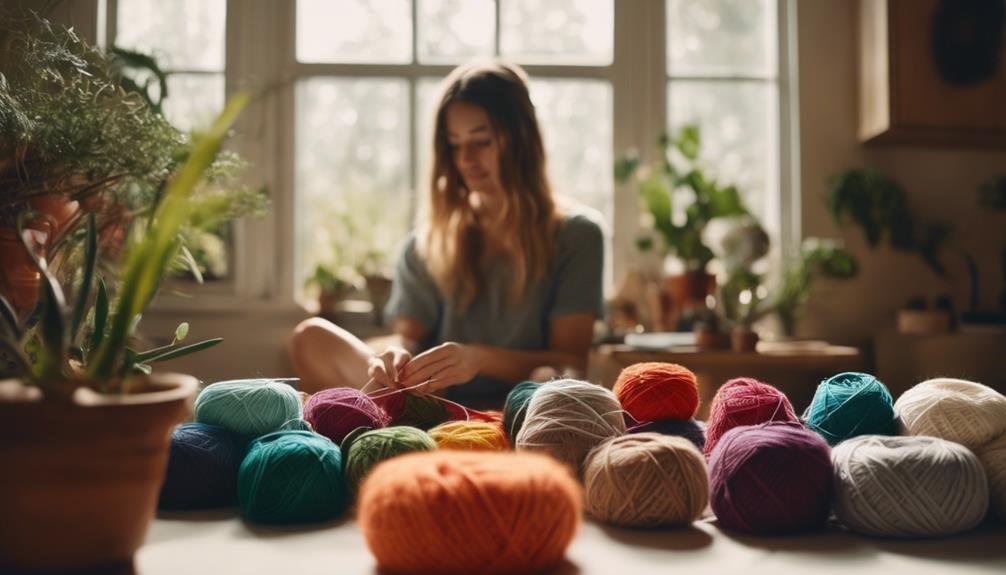
Crochet offers a soothing escape from everyday stress, allowing you to find tranquility in the rhythmic motions of your stitches. As you work with crochet yarn, you engage in a meditative practice that promotes relaxation and reduces anxiety. The repetitive nature of stitching can boost your serotonin levels, enhancing your overall mood and emotional well-being.
Completing a crochet project gives you a sense of accomplishment, contributing positively to your self-esteem. Each handmade item tells your story, adding emotional value and creating a unique connection between you and your crafted pieces. This personal touch transforms your creations into more than just fashion; they become expressions of your individuality.
Moreover, the practice of crochet encourages a return to slow living, fostering mindfulness and creativity in a fast-paced world. By focusing on each stitch, you cultivate patience and attention to detail, skills that can benefit other areas of your life.
Whether you're crafting a cozy scarf or an intricate blanket, the therapeutic benefits of crochet help you unwind and reconnect with yourself. So pick up that crochet yarn and let the magic unfold!
Frequently Asked Questions
Is Crocheting Your Clothes Sustainable?
Yes, crocheting your clothes can be sustainable. You control materials, often choosing eco-friendly yarns. By crafting your garments, you reduce waste and promote ethical practices, fostering a mindful relationship with your wardrobe.
How Can Crochet Be Sustainable?
Crochet's like a time-traveling eco-warrior! You can use organic cotton and recycled fibers, reduce waste with handmade pieces, and embrace natural dyes, making your projects not only unique but also sustainable and environmentally friendly.
Is Crochet Out of Fashion?
You might think crochet's out of fashion, but it's actually thriving! With social media showcasing unique designs and the rise of DIY culture, crochet's become a beloved choice for those seeking individuality and sustainable style.
Is Crochet in Fashion in 2024?
You might think crochet's outdated, but in 2024, it's definitely in fashion. Designers are embracing intricate patterns, influencers are flaunting handmade pieces, and eco-conscious consumers are drawn to crochet's sustainable charm.
How Does Crochet Play a Role in Sustainable Fashion?
Crochet plays a significant role in sustainable fashion sustainability surprise as it emphasizes handmade, durable, and timeless pieces. By using natural, biodegradable fibers and reducing waste, crochet helps minimize the environmental impact of the fashion industry. Its versatility allows for creating unique, one-of-a-kind garments, promoting a more sustainable approach to fashion.
Conclusion
In the world of fashion, 'slow and steady wins the race.'
Embracing crochet not only lets you express your unique style but also contributes to a more sustainable future.
By choosing to crochet, you're reducing waste and stepping away from the fast fashion trap.
So grab those hooks, release your creativity, and remember, each stitch you make is a step towards a more mindful wardrobe.
Together, we can weave a better tomorrow, one loop at a time.
